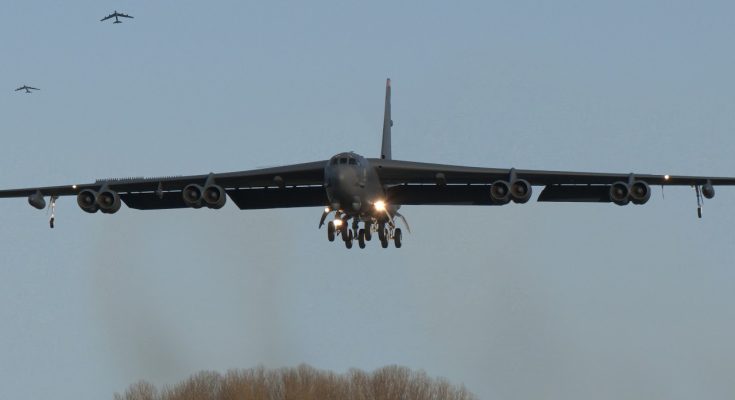The sight of B-52 Stratofortress bombers landing after their flyovers in Europe is a powerful and symbolic event, reflecting both the United States’ military presence in the region and its ongoing commitment to NATO allies and global security. The B-52, a veteran aircraft of the U.S. Air Force, is one of the longest-serving military aircraft in history, having been in service since the 1950s. Despite its age, the B-52 remains a crucial part of America’s strategic deterrence capabilities, particularly in nuclear and conventional bombing missions.
The Role of the B-52 in Europe
The B-52’s deployment to Europe is often a demonstration of U.S. power projection and a reinforcement of the U.S.’s commitment to NATO and its European allies. The U.S. regularly conducts bomber missions in the European theater, as part of exercises or to show solidarity with European nations facing regional threats. The B-52’s role in these operations is not just about showcasing raw military might; it also serves as a strategic tool in demonstrating the capability and readiness of U.S. forces to respond to any crisis or aggression.
These flyovers typically involve the B-52 conducting training missions or participating in NATO-led exercises such as “Baltic Air Policing” or “Noble Justification.” These operations allow NATO forces to practice coordination, increase their interoperability, and demonstrate a united defense front. The presence of such a capable aircraft in the skies over Europe sends a clear message to adversaries, signaling that the U.S. is watching and ready to respond if needed.
B-52’s Strategic Importance
The B-52 Stratofortress is a versatile and formidable platform for both conventional and nuclear missions. With its long range, advanced radar, and enormous payload capacity, it is capable of carrying a wide array of munitions, from precision-guided bombs to nuclear warheads. This makes the B-52 an essential element of the U.S. nuclear triad, which consists of land-based missiles, submarine-launched missiles, and strategic bombers.
The ability of the B-52 to project power far from its home bases is a key reason why it has been deployed in various theaters around the world, including Europe. Its range, combined with refueling capabilities, allows it to operate from the U.S. and travel over vast distances, ensuring that the U.S. can maintain a presence and respond to potential threats anywhere in the world. The bomber’s ability to deliver both strategic and tactical support enhances its value as a deterrent and as a tool for showing American resolve.
The Symbolic Nature of the Flyover
While the B-52’s primary role remains military, the visual spectacle of these bombers flying over European skies is also a potent symbol. It reminds both allies and adversaries that the U.S. remains committed to the defense of Europe and is prepared to take swift action if necessary. These flyovers often take place in conjunction with significant political events or rising tensions, adding to the sense of urgency and relevance.
Furthermore, the presence of such a formidable asset in Europe strengthens the military cooperation between the U.S. and NATO members. It reassures European allies of the U.S.’s continued support and commitment to collective defense, particularly in light of growing concerns about potential threats from Russia or other geopolitical challenges. By flying the B-52 over European airspace, the U.S. is not only displaying its military strength but also underscoring its role as a security guarantor in the region.
Conclusion
B-52 bombers landing after flyovers in Europe are more than just routine missions—they are a clear signal of the United States’ military readiness and its unwavering commitment to its European allies and NATO. The B-52 remains a cornerstone of U.S. strategic defense capabilities, and its presence in European airspace serves as both a deterrent and a reminder that the U.S. will continue to defend its allies in the face of emerging threats. These flyovers highlight the enduring importance of the U.S. Air Force’s long-range capabilities and reaffirm the strength of transatlantic security ties.



